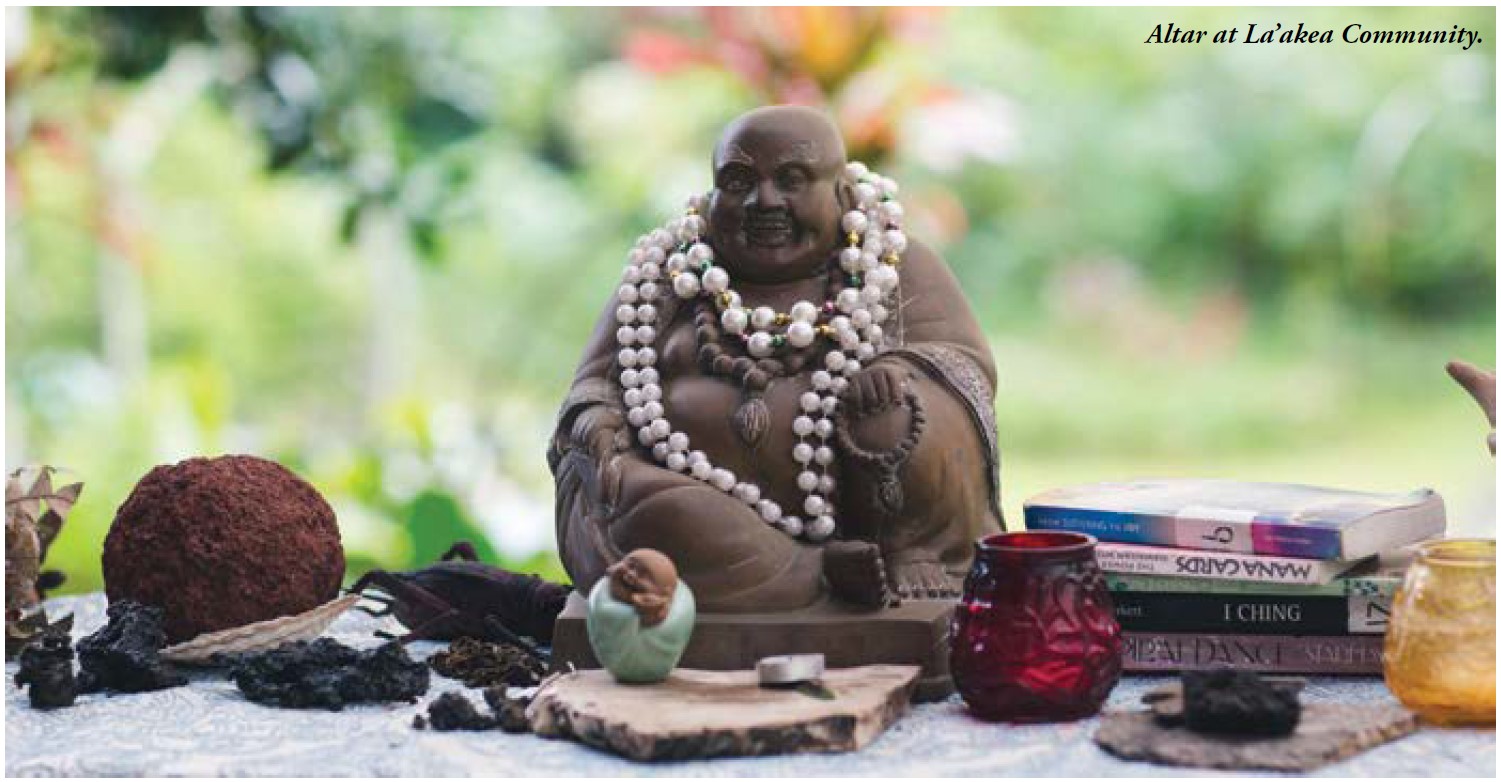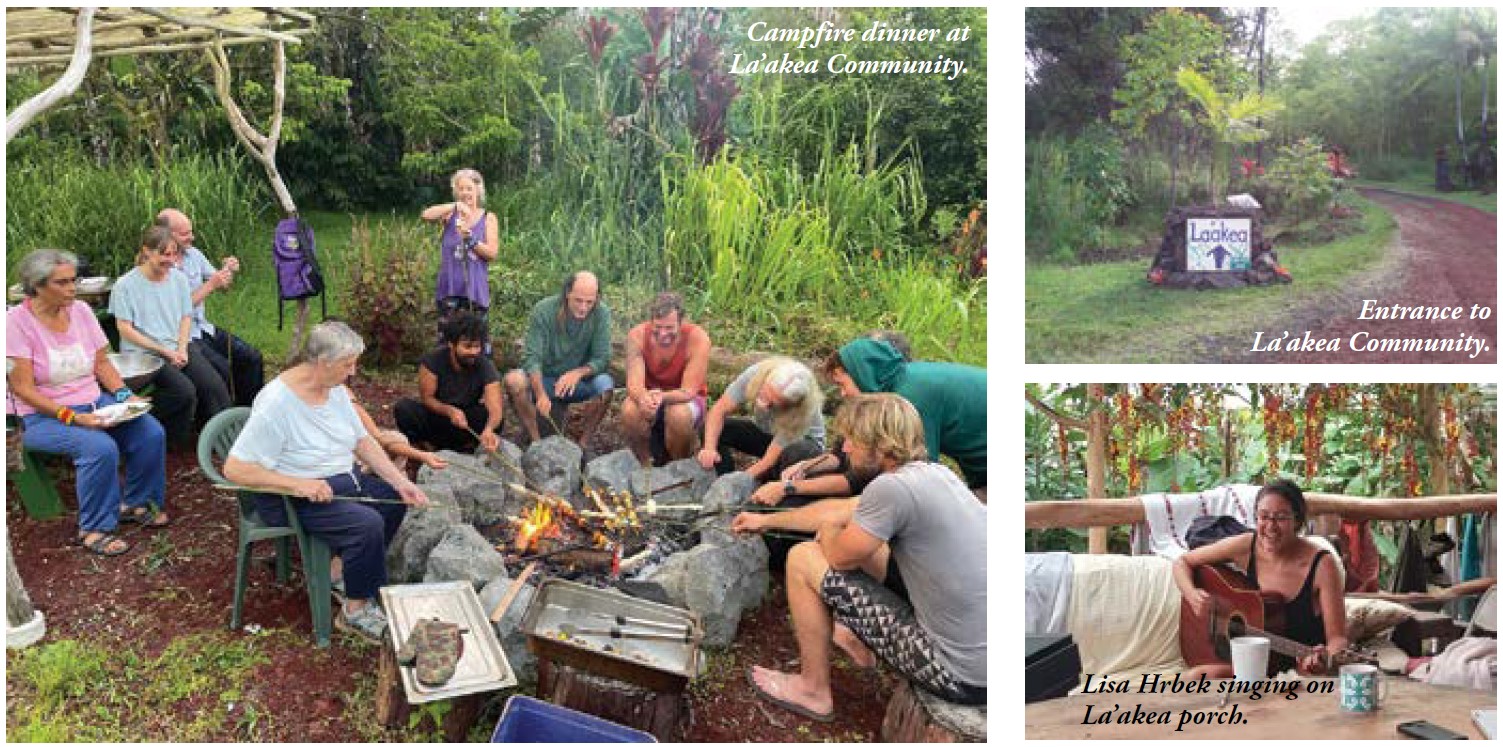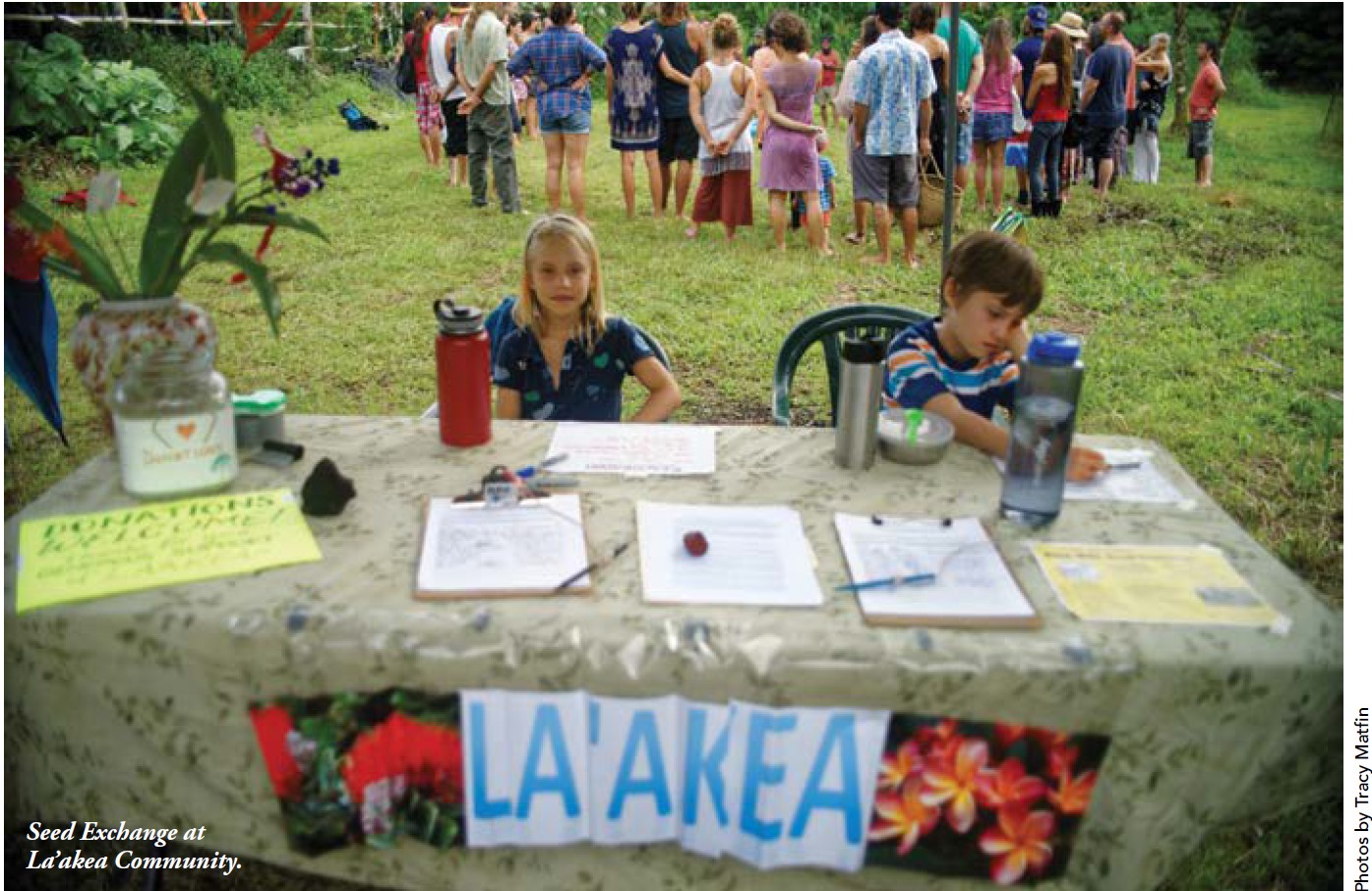By Tracy Matfin

(excerpted from Communities #203, Summer 2024)
Last week I was having garden fresh mint tea with a visitor to our community. She was talking about her daughter, who was home with her dad, and asked me how my family group dealt with conflict with our daughter, Ai’ala, who was off 100 yards away with some friends. I thought about it and started talking, sharing examples. In doing so I realized there have been raised voices at times, and there have definitely been frustrations, but overall we are rather harmonious.
We have raised Ai’ala primarily through accepting and allowing emotional expression, communication, and love—the consistent choice to stay engaged in relationship. As I look deeper I am noticing this is also how we create a lot of harmony at La’akea Community. This community began three years before our daughter was born. She is 15 now, so they have kind of grown up together. Along the way we have learned a lot about conflict and confrontation.
A “conflict” is when two or more individuals have come together, con, to strike, flict, based on differing ideas or viewpoints. A contest ensues to see who can strike harder than the other until a winner is determined. This follows the paradigm of winners and losers, in which there is a dominating force that subjugates another force. One way to move beyond this paradigm is through courageously choosing to meet and talk. Instead of pursuing conflict, they turn toward, or “confront,” the other—con, come together, front, face to face. This action creates opportunity for growth and vulnerability and the possibility for deeper connection and self-reflection.
The key ingredient is commitment—it is the choice to return to relationship in the face of adversity again and again.
When I first decided 25 years ago that I wanted to live in and possibly start an intentional community, a friend said to me, “Why bother? It will never work.” We were having tea on his porch in California.
Dumbfounded and a little crushed, I asked, “Why not?”
He replied: “Because it’s too easy to leave.”
Despite my discomfort with his response, I could see the profound truth in his words. Our modern-day culture is focused on individual independence. Though challenging, it is possible to get a job, have your own residence, drive your own car, etc. It is possible to live independently. The tribal culture so many are looking for did not have that freedom. The interdependence of a tribe was largely based on the need for survival. Unlike now, it was hard and dangerous to leave.
The commitment required today to create lasting relationships—to create tribe—is of a different nature. It requires a deep level of personal commitment so that when the going gets tough, the tough stay together rather than get going.
Whether in discovering how to stay in relationship with a child or with fellow community members, these four behaviors have helped us in our community and as parents:
● Listen actively with your entire being.
● Accept and allow for each individual’s unique humanness.
● Communicate authentically with compassion.
● Share power while honoring rank.
Each is based on love and, together, they create a culture and environment that folks want to stay in.
Listen Actively with Your Entire Being
The first behavior—listening with your entire being—requires patience and practice. One tool we use in our community for this is Peer Counseling. In this practice individuals meet in pairs and take turns actively listening to each other. One of our members, Amara Karuna, has recently published a book about how to learn peer counseling (amazon.com/Heart-Hand-Trade-Holistic-Counseling/dp/B0CH25LZFW). When actively listening to another you are not just paying attention to the words. The words matter the least. The most important part is maintaining a baseline of love and acceptance for the person sharing regardless of what is coming out of their mouth. You hold them in love, Aloha, with the respect and reverence for the life–force energy moving through them.
With 100 percent of your focus you observe their body language, listen to their intonation, notice the way they connect their words, and encourage emotion to move through them. As adults we trade equal amounts of time as the “counselor” and the “client.” However, when we work with children, the child is always the “client.” An easy example is when a child injures themself and begins to cry. You let them cry. You sit beside them, possibly in physical connection or not, depending on their preference, and you listen with your whole body to the experience of their whole body. There is no soothing or distracting or telling them there is no need to cry. Just let them be as you hold your loving presence on them so they feel connected.
This also works well with adults. When Teo cut down JJ’s favorite abiu fruit/shade tree, JJ was livid. JJ approached Teo and passionately shared her thoughts and feelings. Teo was able to stay fully present and listen; there were others present who also were able to listen—to “hold space.” As JJ’s anger was accepted, the energy behind it moved on. She got her needs met to be heard and understood. Actively listening encourages vulnerable sharing by creating a safe container. This container builds connection. As an added bonus—the tree is growing back!
Accept and Allow for Each Individual’s Unique Humanness
The second behavior, accepting and allowing for each individual’s unique humanness, is practiced in Peer Counseling and in another tool we use, the “Forum,” as created by the ZEGG Community in Germany. We mostly learned this tool through Network for New Culture (new-culture.org). Practicing the Forum requires gathering together as a community to create a circle of listeners with one person sharing at a time. Those sharing are invited to share and express anything about what is alive for them as long as it is about them. This circle is facilitated and works best with 10 or more individuals who are in regular contact with one another. The facilitator keeps the energy moving by directing the presenter out of story and into their body. In this practice the members of the audience create the container by listening actively but non-responsively, allowing each presenter’s unique expression. The audience members keep in mind that what a presenter shares is only about the presenter and only for that moment.
Samantha entered the circle with a quickened step and adrenaline in her veins.
“Philip had lunch with Stacy today,” she said as her eyes darted around the room and her pace slowed. “When I walked by they both ignored me.” Sam continued to walk in the circle appearing to contract in on herself, growing silent.
At this moment the facilitator told Sam, “Samantha, exaggerate your motions: bow your head lower; cross your arms across your chest and slow down.” Sam did this and the circle seemed to take a collective breath. We watched tears glide down Sam’s face. “What are you experiencing right now?” the facilitator asked.
“My father’s ignoring me. My sister’s getting all the attention again! What do I have to do to matter? To be seen?” Fire came into Sam’s eyes.
“Increase your pace Samantha. What do you want to tell your dad?”
“I’m amazing and I want to be seen!”
“Say that a few more times in a dance,” came the instructions from the facilitator.
The community of space holders watched Samantha as she released into her body and moved around the inside of the circle with her own fluid motions. Like a community dream, everyone had their own interpretation and carried their own piece from the work Sam was doing. “Let’s bring you into the present,” the facilitator said. “What do you want to tell Philip and Stacy?”
“Don’t shut me out. Please see me.”
The Forum creates a unique opportunity for a group to connect through listening, seeing aspects of themselves, and accepting—in this example, Samantha, in her challenge. The work also provides the practice of not taking on Samantha’s situation. As she shares her feelings we also witness how rapidly feelings can change.
In a very different example, infants model transient emotions very well. One minute the world is going to end as they experience gas buildup, and the next it’s all unicorns and rainbows. (Or conversely if you’re the diaper changer.) When emotional energy is allowed to move and this movement is accepted, individuals’ experiences are thus honored and valued.

Communicate Authentically with Compassion
The third behavior, communicating authentically with compassion, can be learned by studying NVC, Nonviolent Communication, as described by Marshal Rosenberg. This work encourages self-responsibility through self-reflection by identifying feelings and looking behind the feelings for the needs. In the above paragraph I mentioned three “needs”: to be accepted, to be honored, and to be valued. When someone’s needs are met they generally feel peaceful and happy. When someone has unmet needs they may feel uncomfortable with sadness, fear, or anger.
For example: Last Saturday night I went down to the main house to get some food. Monday through Friday the community eats together, but on the weekends you are on your own unless you self-organize with others. I found one of my partners in the kitchen cleaning up their dishes. They had some Greek salad in a container on the counter.
“Hey! That looks yummy. Got any left over?” I asked.
“Nope. This is for Katie and me,” he replied.
I felt sad and mad. Luckily for both of us I kept my mouth shut on the nasty retort that came to mind. I noticed it and walked away.
Why was my first reaction to want to hurt him? When I looked behind my anger and sadness, I noticed I was hungry and I wanted to be included—neither of which was my partner’s responsibility. The most important thing at the moment was to feed myself to aid with self-regulation. Without an understanding of my needs it would have been easy to stay in blame for my uncomfortable emotions and point a finger outside of myself—“Hey, thanks for thinking about me,” said sarcastically—or point it inside at myself—“I could have been more pro-active, if only I’d…,” said with a wimpy whine.
Sometimes NVC gets a bad rap. When thinking about the formula—observation, feeling, need, request—remember that it is a tool that may be used as a hammer, effectively or violently. The element most relevant in NVC is understanding our roles in our emotional experience, learning to listen and speak with compassion (in what’s called “giraffe”), and being aware of judgments and blame (referred to as “the jackal”). Communicating authentically with compassion builds trust, a glue for relationship.
Share Power while Honoring Rank
One more key behavior, vitally critical to the choice to stay in relationship, is power sharing while honoring rank. At La’akea this is outwardly visible in our decision making and in our ownership structure. The land we live on is owned by an LLC. Once an individual completes our membership process they are added to the LLC as an equal member regardless of their Equity Buy-In status. Members participate in our weekly business meetings. Consensus works for our small group of 14 through respect, trust, and developing close connections over time.
Last year we added four new trial members all at once and our meetings s…l…o…w…e…d down. We did not get through the agenda in one meeting for months. As time went on, the meetings flowed more smoothly; empathy and understanding were increasing as we got to know each other better. Getting to know each other establishes rank. Who is more knowledgeable about trees? Who is better in the kitchen? Who specializes in human relations?
I felt rankled when I first heard the word “rank.” Many cells in my body wanted to rebel. With time I learned it did not mean hierarchy, it meant knowledge and experience combined with humbleness which allows for greater trust. Our five-year-old outranks me in imagination and creativity. When he says “Follow me into the ocean” as he walks down the path into our community garden, I listen and drop in with him. The flowers become sea stars, the kale becomes seaweed, and the butterflies are fish! It is fabulous to surrender to his games and his visions. When we reach the machetes and he reaches for one I use my rank in knowledge of safety and say, “The poisonous eels need to be left alone; we do not play with the machetes as we like to avoid injuring ourselves.” Since we have had an exchange of rank we might easily move on. If not, we will pause as more feelings and needs may be discussed. This works because we have chosen to stay in relationship with each other.
All of the above comes together in creating a place where folks enjoy living and growing together. After living with us for six months, Lisa Hrbek wrote this song. You may listen to it on Soundcloud by looking for Lisacapella.
Wounded Joyful
Blemishes and battlescars
Can you show us who you are?
Can you sit through the urge to run?
Can you stay when your smile’s undone?
Together there is more we can face
Come as you are, we will hold an open space
Rest easy, for here it’s safe to be
Wounded, joyful, and free
It’s OK, you can name your doubt
Anger, fear, you can let it out
And when you have a shift in what’s alive
You can give a voice to what’s inside
And when you find you’re in an unfamiliar zone
Let us remind, you don’t have to go alone
Rest easy, for here it’s safe to be
Wounded, joyful, and free
We have a space for all your shades of grey
We have a place where your shadow can play
You can scream or laugh, you can cry or pray
You are welcome here in your fully honest way
Wounded and joyful are we
Come as you are, there’s nothing we can’t see
Rest easy, for here it’s safe to be
Wounded, joyful, and free
Come as you are
We have created a community and raised children where there is encouragement to be as you are; a place where individuals can be heard and accepted, share power, and communicate openly and honestly. It is not all a panacea, it is a lot of growth and self-responsibility, AND we have made it—next year it will be 20 years! Thank you Ai’ala, my daughter; all the members present and past at La’akea; and all the farm supporters and visitors who have woven their energies into the magic of this place! Aloha!

Tracy Matfin is a founder and resident of La’akea Community She teaches permaculture, self-love, and emotional sovereignty. If you want more info on the La’akea community, go to permaculture-hawaii.com.
